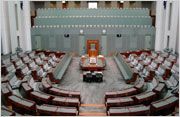Archived News for Green Sector Professionals
An independent report has given Port Phillip Bay a clean bill of health, consistent with its condition over the past decade.
The Office of the Environmental Monitor (OEM) has released its fourth annual review of the health of Port Phillip Bay assessing data collected during the past four years.
Climate Commission warns of warming impacts on Tasmania
The Climate Commission has released a report, The Critical Decade: Tasmanian impacts and opportunities, which warns that changes in Tasmania’s climate will have far-reaching implications for industries including agriculture, tourism, electricity generation, fisheries, as well as for biodiversity and human health.
$1 billion funding for clean technology grants
The Federal Government has launched two new programs with funding of $1 billion for manufacturers to improve energy efficiency and reduce pollution.
Cape Riche desalination plant given conditional approval
The Cape Riche desalination plant has been granted conditional approval by the Western Australian Environmental Protection Authority (EPA).
Queensland releases renewable energy plan
The Queensland Government has released its Queensland Renewable Energy Plan (QREP) 2012, following a review of the original plan first launched in 2009.
Queensland Energy Minister Stephen Robertson said the plan positions Queensland to leverage up to $8.9 billion in renewable energy investment and deliver 9000 gigawatt hours of renewable energy generation by 2020.
“It will help deliver on our original QREP goals to create up to 3500 new green jobs and reduce greenhouse gas emissions by up to 40 million tonnes.
“The plan also establishes Queensland’s case as a major competitor for new renewable energy investment, projects and industry growth in Australia.
“For example, the Australian Government's Clean Energy Future Plan includes more than $10 billion in new clean energy funding and targets up to $100 billion in private investment by 2050.
“Substantial opportunities will emerge for Queensland from this national plan. With a strong ongoing program of initiatives and new focus on collaboration and capacity building, QREP 2012 aims to position Queensland as a primary beneficiary.”
Mr Robertson said the state had achieved significant renewable energy success through the original QREP 2009.
“We have increased Queensland’s renewable energy generation capacity 66 per cent from 745 megawatts in 2008 to more than 1235 megawatts today – that’s enough to power roughly 640,000 homes per year.
“We also smashed our 500 megawatt Virtual Solar Power Station target three years early.
“Queensland’s renewable energy industry has attracted around $2.7 billion in total public and private investment and supports more than 1800 jobs.”
Mr Robertson said the Queensland Renewable Energy Plan 2012 will build upon Queensland’s early success with small-scale solar achieved with the help of Bligh Government initiatives like the Solar Bonus Scheme and Solar Hot Water Rebate Scheme.
“QREP 2012 seeks to scale up these efforts and accelerate deployment of medium and large scale renewable energy generation projects,” he said.
“We are already co-funding the world’s largest solar integration project at the Kogan Creek power station and have been chosen by the Commonwealth to host the proposed 250 megawatt Solar Dawn solar thermal power project at Chinchilla.
“There are also exciting developments ahead to harness Queensland’s abundance of other renewable energy resources like wind, geothermal, solar thermal and bioenergy.”
QREP 2012 refocuses the Queensland Government’s renewable energy agenda under three key objectives:
Fitzroy water partnership starts
The Queensland Government has announced the commencement of the Fitzroy Partnership for River Health program.
NSW Scientific Committee membership announced
The NSW Minister for the Environment Robyn Parker has announced the new membership of the NSW Scientific Committee, the body charged with identifying threatened species and key threatening processes.
NSW Marine Parks audit report released
The NSW Government has released the Independent Scientific Audit Report into Marine Parks in NSW, and called for submissions in response.
Development pressures on Great Barrier Reef to be assessed
The Queensland and Federal Governments and the Great Barrier Reef Marine Park Authority (GBRMPA) have signed a new agreement on assessment processes for development along the Queensland coastline and protection and management of the Great Barrier Reef.
Queensland signs up to CSG agreement
Queensland has become the first state to sign up to the newly strengthened regulatory framework for coal seam gas and large coal mining developments.
Burke slams Tasmanian timber campaigners
Federal Minister for Sustainability and Environment Tony Burke has slammed the ‘irresponsible campaigns against Tasmania’s overseas timber market’, saying their efforts are sabotaging local jobs and undermining environmental efforts.
Study shows importance of vegetation for freshwater streams
More than twenty years of biological monitoring have confirmed the importance of vegetation for protecting Australia's freshwater streams and rivers against the ravages of drought and climate change.
RMIT researcher in international energy breakthrough
Researchers at the Massachusetts Institute of Technology (MIT) and RMIT University have made a breakthrough in energy storage and power generation.
Chloe Munro appointed to head up Clean Energy Regulator
The Federal Government has appointed Ms Chloe Munro, currently the Chair of the National Water Commission, as the Chair and Chief Executive Officer of the new Clean Energy Regulator.
Low carbon oil researcher wins RACI medal
Professor Thomas Maschmeyer, Professor of Chemistry and ARC Future Fellow at the University of Sydney, has been awarded the Royal Australian Chemical Institute’s 2011 Applied Research Medal For his work on catalysis and sustainable processes, including developing methods to create low carbon crude and heavy fuel oil substitutes.
Strong response to Carbon Farming Futures Fund programs
More than 500 applications have been received from universities, land managers, industry and government agencies for the Federal Government's funding program to test and develop new ways for farmers to reduce carbon emissions.
Research project to test geosequestration of CO2
Curtin University researchers have been awarded a $1.4 million grant to independently assess the injection capacity of carbon dioxide (CO2 ) at selected sites, to assist local communities, industry and government to reduce greenhouse gas emissions.
Gorgon Project funding for four WA conservation project announced
WA Environment Minister Bill Marmion has announced funding of more than $23million over the next seven years for four conservation projects as part of a $60 million Gorgon Joint Venture conservation package over the next 30 years.
New roofing materials target carbon positive outcome
Roofing materials that double as solar panels and can also moderate the temperature of buildings are among the next-generation building products being developed at UNSW.
Victorian carbon capture and storage project funded
The Australian and Victorian Governments will collectively provide $100 million towards the development of Victoria’s first carbon capture and storage (CCS) project - CarbonNet.
CarbonNet is the second project selected for funding under the Australian Government’s Carbon Capture and Storage Flagships program.
The CarbonNet Project aims to capture carbon emissions from power plants, industrial processes and new coal-based industries in the Latrobe Valley and store it in geological basins.
The combined funding of $100 million ($70 million from the Commonwealth and $30 million from the Victorian Government) will support feasibility work as part of the $1 billion plus CarbonNet project to demonstrate low emission brown coal electricity generation in the region.
The Commonwealth Minister for Resources and Energy, Martin Ferguson said clean energy innovation like this could help power stations cut their emissions while continuing to secure the economic prosperity of the region.
“Investment in CCS is part of the Commonwealth’s suite of support for a range of clean energy technologies designed to reduce greenhouse gas emissions over time,” Minister Ferguson said.
“The economic base of the Latrobe valley depends on brown coal and while the Government is committed to cutting CO2 emissions, the last thing we want to do is cut jobs in the process. Projects like CarbonNet will help shape a new economic future for this critical region.”
The Victorian Department of Primary Industries manages the CarbonNet Project. The feasibility work will include modelling and testing of potential CO2 storage sites.
In addition to announcing funding for CarbonNet, Minister Ferguson also announced that the Victorian Government has been awarded an offshore tenement for CO2 storage site exploration in the Gippsland Basin. Further, both governments awarded the HRL Dual Gas project a final six-month extension on the previous date of 31 December 2011 to meet the conditions of the respective funding deeds.
More detail on the Flagships program can be found here and the project here
Government likely to strike $10 million waste dump agreement
The Federal Government has reportedly struck a deal with the Northern Territory Opposition that could result in the country’s first ever Nuclear Waste Dump likely being constructed in the territory.







